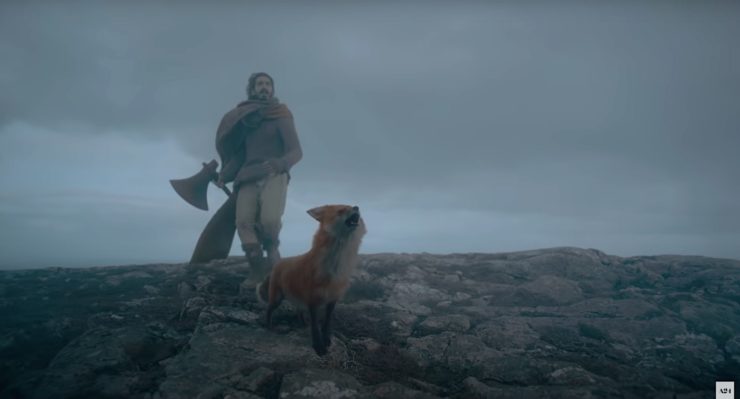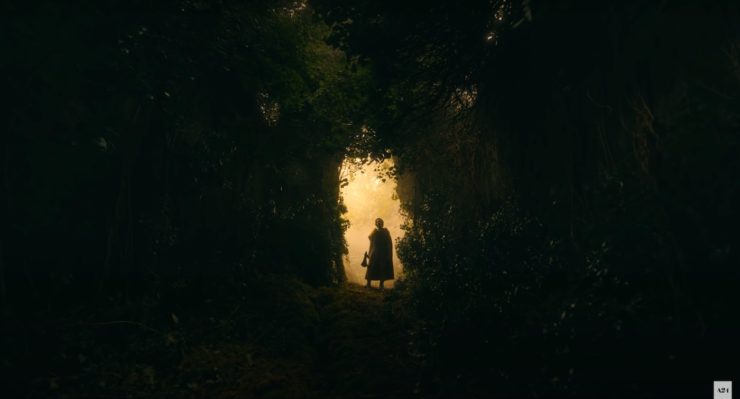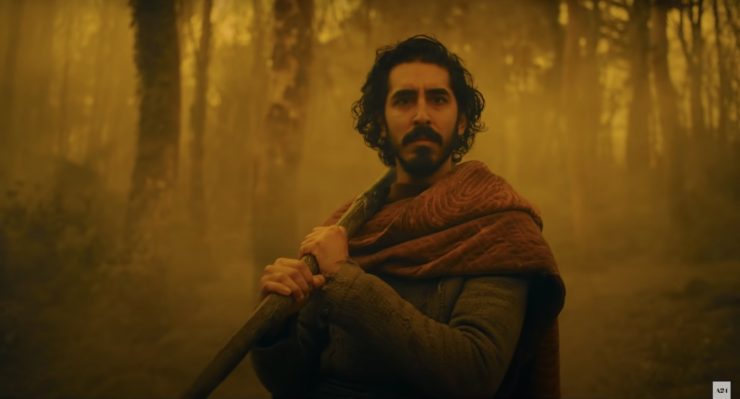David Lowery’s The Green Knight is so beautiful it becomes painful at times. Lush, witty, dreamlike, it retells a 14th Century tale not by updating the story, but by roughing the details up a bit, and making some subtext text. More than anything, it feels like a successor to The Seventh Seal or Robin and Marian, and if you can see it in the theater (safely!), you should.
It also succeeded in knocking the soundtrack to Inside out of my head for two whole hours! A feat nearly as impossible as surviving a beheading.
First things first: the entire cast is great, Dev Patel is magnificent, and the whole film drips with sensuality like a pine forest after a thunderstorm. My colleague Christina Orlando and I were whimpering audibly by the time Gawain met up with the Lord and Lady Bertilak, (Joel Edgerton and Alicia Vikander), The Medieval Couple Who Couldn’t Help Noticing You Across the Bar. But to be clear this certainly isn’t gratuitous, it simply matches the tension in the poem between Gawain’s dedication to purity and the Bertilaks’ obvious need for a third.
(Some spoilers ahead for the original poem and movie adaptation.)
In case you don’t remember the poem, here’s a quick-ish summary: King Arthur and his Knights are celebrating Christmas when a giant Green Knight bursts into the hall, and asks them all to play a game. Gawain, Arthur’s nephew, is the one Knight brave enough to accept, and told he has to strike a blow that will be returned in kind (next year), lops the Green Knight’s head off. It’s only after the totally alive Green Knight picks his head up and says the Middle English equivalent of “See you next Christmas, sucker!” that Gawain realizes the game might be a little intense.
Being a worthy Knight, he heads off to get beheaded a year later, having adventures we don’t see along the way, before stopping in at the castle of Lord and Lady Bertilak. That Lord asks him to play a different game. The Lord will go hunting each day and bring back a prize; in exchange Gawain has to give the Lord anything he gets throughout the day. Lady Bertilak tries to Mrs. Robinson the shit out of Gawain, but our boy mostly resists, and dutifully gives the Lord the innocent-ish kisses he receives each day.
Buy the Book


Spear
However! For proper allegory effect, Gawain does accept a green girdle that will protect him from all harm, which he hides from Lord Bertilak because, underneath all of his Round Table charisma, Gawain is scared to death of losing his head. Of course, Bertilak is probably the Green Knight, this whole thing has been a huge test, and in the end the Knight nicks Gawain and chides him for hiding the girdle rather than having faith that God would save him. When Gawain gets home, ashamed of his loss of courage, the rest of the Round Table think the whole story’s hilarious and add green girdles to their uniforms to remind themselves to be humble. Oh, and the whole thing was Morgan le Fay messing with them, probably.
David Lowery takes this tiny thread of cowardice and knits a beautifully intricate piece of chainmail. His Gawain isn’t a knight, he’s a… how to put this politely? How about hot, drunken slattern? He spends most of his time in either the brothel or tavern, staggers off to Christmas Mass still drunk from his Christmas Eve carousing, refuses to commit emotionally to the sex worker he spends most of his time with, and gets in brawls when people call his mother a witch. He seems to want to be a knight, sometimes, but he also seems to just want to be Arthur’s Large Adult Nephew, having fun as long as possible. This gives the story a different drive than that of the original poem. Rather than worrying for Gawain’s life, or maybe his virtue, we become invested in whether he’s going to gain a sense of honor before he has to face the chopping block. And even if he does, will the honor truly be his? Or a sense of responsibility forced on him by the Court?
The story is a picaresque adaptation, taking us along with Gawain on his quest to face the Green Knight. It really does feel like Monty Python and the Holy Grail at times, if that movie had leaned further into eeriness and beauty. Lowery commits to the Medieval world as one of magic and mystery, where inexplicable things can happen at every turn.
This movie is a visual poem. It’s the kind of thing that reminds me why I go to theaters, and why I love film. After this last year and a half, getting to sit in a dark room and bask in these images felt like I was breathing air again for the first time in lonnnnng time. The sound design is extraordinary. This will sound weird, but I felt every footstep in this movie. Every crunched pine needle, every hoof-clop, every soft foxpaw pad. Gawain spends a fair amount of time in the woods, and the orchestration of birdsong, insects, and dripping water is so immersive it nearly becomes hallucinatory. (I found myself thinking of Martin Scorsese’s use of natural sound in Silence.) In addition to that, the music is just gorgeous—a mix of medieval orchestration, folksong, and eerie horror movie soundtrack that drive home the fact that Gawain is in constant danger.

A24 continues its stellar livestock track record. The movie opens with a fight between a goose and goat, Gawain’s most touching relationship is with his beloved horse, and then a very persistent fox shows up. And the fox is GREAT—a worthy successor to Black Phillip and First Cow.
At its heart this is a story of a medieval manbaby who realizes that in order to be a man, he needs to learn to make sacrifices and honor his commitments. It’s a weird beautiful movie, unlike anything I’ve seen in years, and if you want a haunting film experience I can’t recommend it highly enough.
Now, if you’ll forgive me I’m going to need to venture into the mists of spoiler territory to talk about a couple really interesting moments! So if you want to go in completely cold, which I recommend you do, bail out here and come back later!
***
I expected them to ramp up the sexuality of the story. The poem already feels like a cleaned-up version of itself, if that makes sense: Are we really meant to believe that Gawain and the Lady only shared a couple of chaste kisses, which he promptly delivered to the Lord each evening? Was it really only a green girdle that he kept a secret? But the film takes most of that subtext and makes it text, with the girdle scene in particular going further than any previous version of this story.
Where it doesn’t go quite as far as I expected was with queerness—where the original gets a lot of mileage out of the idea that Gawain will have to give the Lord anything he gives the Lady, in Lowery’s version the Lord is fairly open about wanting to get his hands on Gawain’s girdle, but they stop after one kiss.
What frankly shocked me was in how they knotted the religious imagery into the film. And here’s where, again, if you want to go in cold, look away: I wasn’t expecting this movie to be a riff on Last Temptation of Christ? Like at all. And yet. Where the poem is infused with medieval spirituality, Gawain goes to meet the Green Knight in full knowledge that it probably means his death, and does his best to prepare for it. He bears a shield with a pentangle on its front, protecting himself with the symbol of the Five Wounds, and an image of Mary on the inside, where he can contemplate her face. He’s not pious like Galahad in some of the other Arthurian stories, but he clearly comports himself like a good Medieval Christian. He doesn’t seem to become more religious during the quest, and says he’s doing it because he wants honor, but never puts any feeling into that word. After he accepts the Lady’s girdle, he goes to meet the Green Knight, but his courage fails and he runs home. We then watch as, protected by the girdle and everyone’s assumptions that he is a triumphant knight, he is crowned King, fathers children, marries a suitable woman, and lives long enough to become the villain.

But wait! It turns out that this entire life is simply a fantasy playing out as he gathers his courage to receive the Green Knight’s blow. He signals his decision to return to regular time, and lose his head, by pulling the girdle, agonizingly slowly, from a wound in his side, as light bounces off his mighty crown. Then he’s back in his body, waiting for his death. It’s hard to describe, but this felt to me like a beautiful reconciliation of the pre-Christian imagery underlying a lot of Arthurian tales (and Christmas, for that matter) the idea of willing sacrifice that’s baked into Christianity, and the general acceptance of mortality that comes with growing up. As well as a note perfect meditation on the controversial last third of Last Temptation of Christ, where Jesus comes down from the cross and lives a mortal life before giving it up to be crucified. The point being, of course, that he has to know what he’s sacrificing for the sacrifice to actually be meaningful. There’s also a fair amount of “One ___, many faces” happening here, with the Green Knight seemingly being connected with Arthur and Lord Bertilak and maybe even Gawain’s mother, and with Alicia Vikander playing two roles. This is seriously just Archetype: The Motion Picture. And I LOVE a good archetype.
Honestly there is SO MUCH MORE I could say about this film, but since LTOC is one of my all-time favorite movies that’s the bit that hit me the hardest. But I’ll shut up at this point, before this review becomes a pain in the neck. You’ll undoubtedly find other resonances and references, and I hope you’ll talk about them in the comments!
Leah Schnelbach hopes no one ever takes a blacklight to Castle Bertilak. Come join them in the raucous mead hall of Twitter, and tell them a tale of yourself!











Excellent review. It definitely makes me want to see the movie.
Also thanks for getting George Michael stuck in my head.
Great review! Another film it reminded me of was The Seventh Seal. Both films are meditative and eerie and somewhat obsessed with the idea of honor and death.
There wasn’t much mentioned in your review about Morgan Le Fey but I love what Lowery did with her character.
Have not seen The Green Knight (yet!) but really feeling the need after this fine review, Ms. Schnelbach. With the dream sequence, does Gawain the king being wounded suggest that he has become the Fisher King (Wounded King), the keeper of the Grail who was unable to heal himself and whose lands were barren in consequence?
Ah, this was very interesting! I connected that final fantasy sequence with “The Green Ribbon” horror story (refusing to take the ribbon/girdle off, and when the character finally does, off goes the head); the connection to the Last Temptation is really resonant and another interesting layer.
Now I *do* want to see it!
Leah, or mods, please make minor correction of typo in light bounces of his mighty crown. of = off
@6 – Corrected, thank you!
mod, also fix “crunched pin needle, ever hoof” to “crunched pine needle, every hoof”
I thought the film was overblown and pretentious. One reviewer said it best ” Its as if Terrance Malick were to direct an episode of Game of Thrones” !
This was always one of my favorite medieval stories, so I was a bit skeptical about a Hollywood version – now I REALLY have to see the film.
While we are mentioning corrections, please correct “Gawain will have to give the Lord anything he gives the Lady” — it should be “anything he GETS FROM the Lady”.
I just saw The Green Knight and found it drab, plodding, and so poorly lit that the Green Knight didn’t even look freaking green most of the time. Joel Edgerton was good and Dev Patel deserves an Oscar for how much he was able to make out of so little, but almost everyone else seemed to be sleepwalking through the movie.
9. You probably already know this, but the project was originally Malick’s – I haven’t seen the film, but the trailer had his fingerprints all over it (one of the reasons I checked the film’s background was because I couldn’t reconcile the – comparatively – young director with the film’s overall look) but he seems to have left after creative differences. My guess is that Malick had one vision of the film whereas the producers had another. They wanted something more in line with Game of Thrones, probably. Or at least, something that was more overtly a work of fantasy. Only classier (Malick’s job). So maybe the end result was a mixture of the two? 50% Malick*, 50% schlock?
* an acquired taste, admittedly.
@11, Yeah, I could tell it was dark, literally, in the trailers. I really hate movies where you desperately want to give the characters a damn flashlight! And it’s obviously going for a Dung Ages look.
@12: “because I couldn’t reconcile the – comparatively – young director with the film’s overall look.”
The film’s style is pretty much in keeping with that of Lowery’s earlier films. That’s what his films look and feel like. Malick’s always been an influence on him, all the way back to his first film, Ain’t Them Bodies Saints.
“My guess is that Malick had one vision of the film whereas the producers had another. They wanted something more in line with Game of Thrones, probably. Or at least, something that was more overtly a work of fantasy. Only classier (Malick’s job). So maybe the end result was a mixture of the two? 50% Malick*, 50% schlock?”
The film has little in common with Game of Thrones, and A24 has previously supported productions that are less mainstream or commercial than that show. They did Midsommar, for example. Or look at the trailer for their upcoming film Lamb, which played in front of The Green Knight” when I saw it.
There’s no schlock here.
Just to follow that up, here’s the trailer to Lowery’s first film for comparison:
https://www.youtube.com/watch?v=ga0c0v-stK0
And here’s the trailer for his second –
https://www.youtube.com/watch?v=fPOamb6d_20
I guess it all depends on which cap Lowery was wearing? Admittedly, I only saw the trailer for ‘The Green Knight’, so what do I know? But even that was like watching two different films; an arthouse movie and something more mainstream – hence my curiosity about the film’s history and my assumption that there were two, mutually contradictory agendas at work. Plus Malick first became interested in the story after directing ‘The Thin Red Line’ – ie, over twenty years ago – which must count for something (even if Lowery getting credits for pretty much everything).
I found the film gorgeous — but very slow moving.
The comparison to Robin and Marian is, in a way, apt: because that film, too, was a travesty of medieval culture. Marian, who has taken vows of celibacy, jumps into bed with Robin without a qualm. Later, she murders him sans last rites, lovingly sending his unshriven soul to Hell.
Similarly, Gawain’s relationship with his leman — his peasant mistress — is anachronistic. Watching the film, I imagined dialogue in which he says to her, “You know I’m going to have to marry some noblewoman I’ve never met, because an alliance with her family is necessary for the survival of mine.“
But of course she would know that already. Her greatest hope would be that any child she bore him would be accepted into the nobility (like William the Bastard of Normandy).
The scene in the interminable fantasy flashforward, in which King Gawain cruelly tears away her newborn baby, is absurd for a number of reasons, but one of them is that she would be eager to have her child adopted into the upper class, where he won’t go hungry. For herself, her greatest hope would be to marry a farmer with a good piece of land.
Aside from being interminable, as I said, the fantasy flashforward makes little sense. Breaking his oath to the Green Knight wouldn’t suddenly turn Gawain into a villain. Instead — and this is why the poem’s Gawain never seriously considers reneging — it would guarantee that the Green Knight would come back, revealing Gawain’s dishonor and demanding even greater penalties; say, the head of King Arthur.